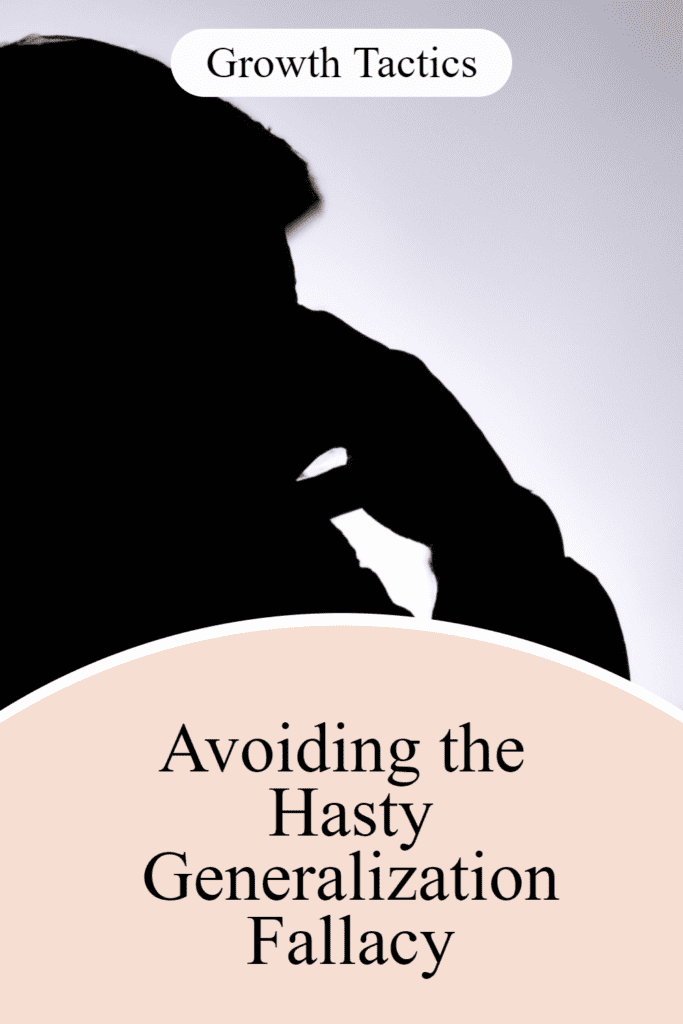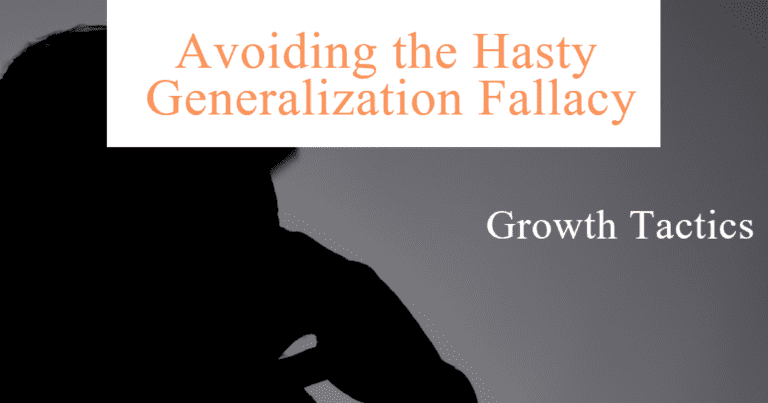Are you tired of logical fallacies making their way into your everyday arguments? One fallacy that is all too common is the hasty generalization fallacy. This informal fallacy involves drawing a conclusion based on insufficient evidence, often in the form of a small sample size. In this article, we will take a closer look at the hasty generalization fallacy, provide examples, and offer tips on how to avoid falling into this logical trap.
Jump To Section
What is the Hasty Generalization Fallacy?
The hasty generalization fallacy occurs when a conclusion is drawn based on a small number of instances of a phenomenon, without using logical and conclusive evidence. Often, an individual will use a specific claim or anecdotal evidence to generalize, without considering how it relates to a larger population. This fallacious form of reasoning can be seen in many different contexts, including politics, advertising, and everyday arguments.
Examples of the Hasty Generalization Fallacy
I’ve seen the hasty generalization fallacy pop up in all sorts of places, and it’s something we all need to watch out for. Let’s break it down with some examples that might hit close to home.
In Politics
Politicians love to use hasty generalizations. Imagine a politician saying, “All immigrants are criminals!” just because they heard about one immigrant committing a crime. But that’s not fair or true, is it? Most immigrants I’ve met are hardworking folks trying to build a better life.
Here’s another one I’ve heard: “Young people are lazy!” This might come from someone who met a teenager who didn’t want to work. But we all know plenty of ambitious young people, right? It’s important to look beyond these quick judgments and see people as individuals.
In Advertising
Ads can be tricky with hasty generalizations. For example, a shampoo ad might claim, “9 out of 10 people prefer our brand!” But it turns out they only asked 10 people. That’s not enough to speak for everyone!
Or how about this one: “Our diet pill works for everyone!” But they’re basing that on just a few success stories. We’re all different, and what works for one person might not work for another. It’s crucial to think critically about these claims and find the truth.
Effects of Hasty Generalization
Hasty generalization can have several effects that are important to consider.
Spread of Misinformation: One of the significant effects of hasty generalization is the potential spread of misinformation or misconceptions. When someone draws a conclusion based on limited or biased evidence, it can create a false belief that is not supported by actual data or observations. This can be particularly concerning in areas such as medicine or science, where relying on faulty information can lead to harmful decisions or actions.
Creation of Stereotypes and Prejudice: Hasty generalizations can also contribute to the development and perpetuation of unfair stereotypes or prejudice. When individuals reach a conclusion about an entire group of people based on just a few examples of individual experiences, it can lead to harmful generalizations that can dehumanize and marginalize specific populations.
Undermined Credibility: Another effect of hasty generalization is the potential undermining of the arguer’s credibility. When someone makes an argument based on limited or insufficient evidence, it weakens the overall soundness and persuasiveness of their argument. This can impact how others perceive their reasoning and may lead to skepticism or the dismissal of their claims.
It is important to be aware of these effects and to actively avoid hasty generalizations, as they can have significant consequences. By taking the time to gather sufficient and unbiased evidence, considering alternative explanations, and seeking diverse perspectives, one can minimize the likelihood of falling into the trap of hasty generalization.
How to Avoid the Hasty Generalization Fallacy
To avoid falling into the trap of the hasty generalization fallacy, it is important to consider the following strategies:
1. Use a Sufficient Sample Size
One of the key factors in avoiding the hasty generalization fallacy is ensuring that your sample size is large enough to be statistically significant. If you are making a claim about a larger population, it is important to gather data from a representative sample that reflects the diversity within that population. By using sufficient sample size, you can minimize the risk of drawing unwarranted generalizations.
2. Consider Alternative Explanations
When making a generalization, it is crucial to consider alternative explanations for the observed phenomenon. Avoid jumping to conclusions without thoroughly examining other possible factors that could be influencing the situation. By critically evaluating different perspectives and gathering comprehensive evidence, you can avoid the tendency to make hasty generalizations.
3. Seek a Variety of Perspectives
To gain a comprehensive understanding of a topic and avoid making hasty generalizations, it is important to seek a variety of perspectives. By engaging with different sources of information, and diverse viewpoints, and considering a range of evidence, you can broaden your understanding and avoid relying on limited or biased data. Consulting experts, conducting thorough research, and engaging in open-minded discussions can help you develop a more nuanced perspective.
4. Recognize the Limitations of Anecdotal Evidence
Anecdotal evidence refers to personal stories or individual experiences that are not necessarily representative of a larger trend. While anecdotes can be compelling, they should not be used as the sole basis for drawing conclusions. Recognize the limitations of anecdotal evidence and be cautious of making sweeping generalizations based on isolated incidents.
5. Seek Sufficient and Unbiased Evidence
When making arguments or drawing conclusions, strive to gather sufficient and unbiased evidence. This means seeking out reliable sources, conducting comprehensive research, and critically evaluating the quality of the evidence at hand. Relying on a strong evidence base will help you avoid the pitfalls of the hasty generalization fallacy.
By incorporating these strategies into your thinking and decision-making processes, you can mitigate the risk of committing the hasty generalization fallacy. Remember, drawing conclusions based on insufficient evidence leads to faulty reasoning and unreliable generalizations. Take the time to gather comprehensive and representative data, critically evaluate alternative explanations, and consider a variety of perspectives to strengthen the quality and validity of your arguments.
Conclusion
By understanding what the hasty generalization fallacy is and how it can be avoided, individuals can improve the quality of their arguments and avoid logical errors in reasoning. Remember to draw conclusions based on conclusive evidence and avoid hastily assuming that a generalization is justified based on the actions of one or a few people. With these tips in mind, you can engage in more effective and logical arguments, whether in everyday situations or in professional contexts.
Remember:
- The hasty generalization fallacy occurs when a conclusion is drawn based on insufficient evidence
- Use a large enough sample size and ensure that the data used is representative
- Avoid using anecdotal evidence or data from a small number of instances to support your claims.
FAQ
What is the hasty generalization fallacy?
The hasty generalization fallacy is an informal logical error where a conclusion is drawn based on insufficient evidence, typically from a small sample size. It involves making broad claims about a large group or population based on limited observations or examples.
Why is the hasty generalization fallacy problematic?
This fallacy can lead to the spread of misinformation, creation of harmful stereotypes and prejudices, and undermining of the arguer’s credibility. It can result in faulty decision-making and unfair judgments about groups or situations.
How can I recognize a hasty generalization in an argument?
Look for conclusions that seem to be based on limited examples or personal anecdotes rather than comprehensive data. Be wary of statements that use words like “all,” “every,” or “always” when describing large groups based on small samples.
What are some common areas where hasty generalizations occur?
Hasty generalizations are often seen in political debates, advertising claims, and everyday arguments. They can appear in any context where people make broad claims without sufficient evidence.
How can I avoid making hasty generalizations?
To avoid this fallacy:
- Use a sufficient sample size when collecting data
- Consider alternative explanations for observations
- Seek a variety of perspectives on the topic
- Recognize the limitations of anecdotal evidence
- Gather sufficient and unbiased evidence before drawing conclusions
Can you give an example of a hasty generalization?
A common example is when a politician claims “all immigrants are criminals” based on a few isolated incidents. This generalizes the actions of a few individuals to an entire population without sufficient evidence.
How does the hasty generalization fallacy relate to stereotyping?
Hasty generalizations often lead to stereotyping by applying characteristics observed in a small group to a larger population without justification. This can reinforce and perpetuate harmful prejudices.
Is anecdotal evidence always a hasty generalization?
While anecdotal evidence isn’t always a hasty generalization, it often leads to one if used as the sole basis for a broader conclusion. Anecdotes can be valuable, but they should be used cautiously and in conjunction with more comprehensive data.


